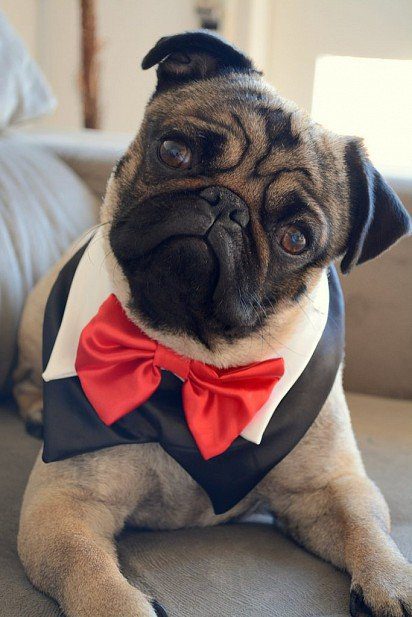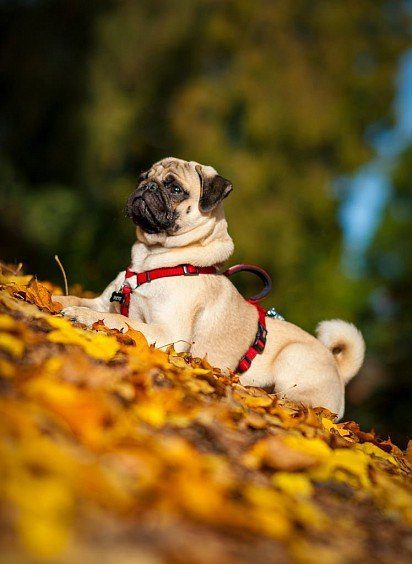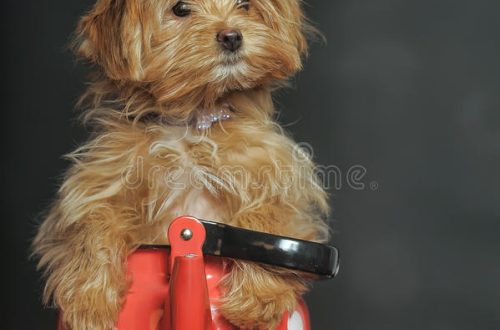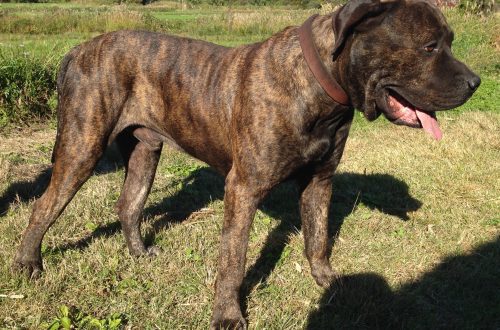
Pug
The pug is an ancient and consistently popular breed throughout its history. This is an excellent companion dog for city dwellers.
| Country of origin | China |
| The size | small |
| Growth | 18–20 cm |
| Weight | 6.3–8.1kg |
| Age | about 12 years old |
| FCI breed group | companion dogs |
Contents
Basic moments
- Pugs are friendly towards family members, strangers and other animals.
- Aggressive behavior is completely atypical for them.
- These dogs easily adapt to your lifestyle.
- They are funny and sociable pets.
- They don’t need long walks.
- Suitable for inexperienced owners.
- Due to the peculiarities of physiology, it is vital to monitor the temperature regime of keeping pugs.
- They are prone to obesity, so a balanced diet is required.
- The owner needs to carefully monitor their health.
- Pugs are not rare dogs, which means that you can buy a puppy in almost any city.

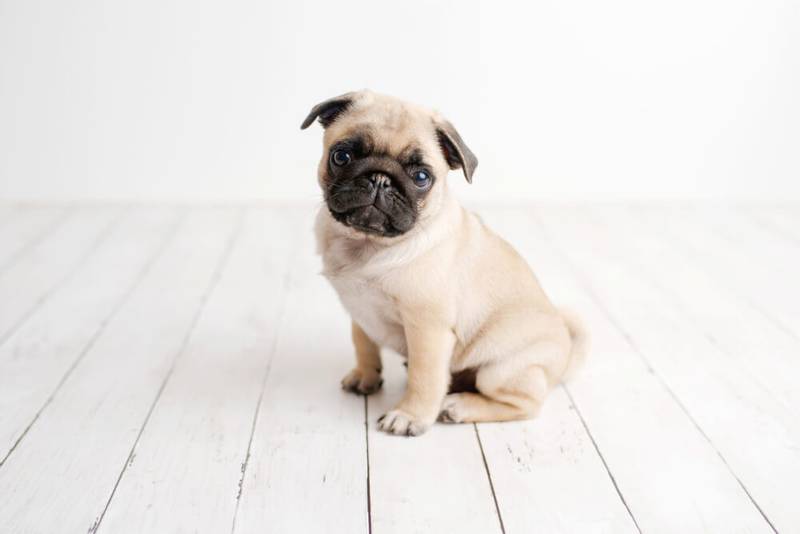
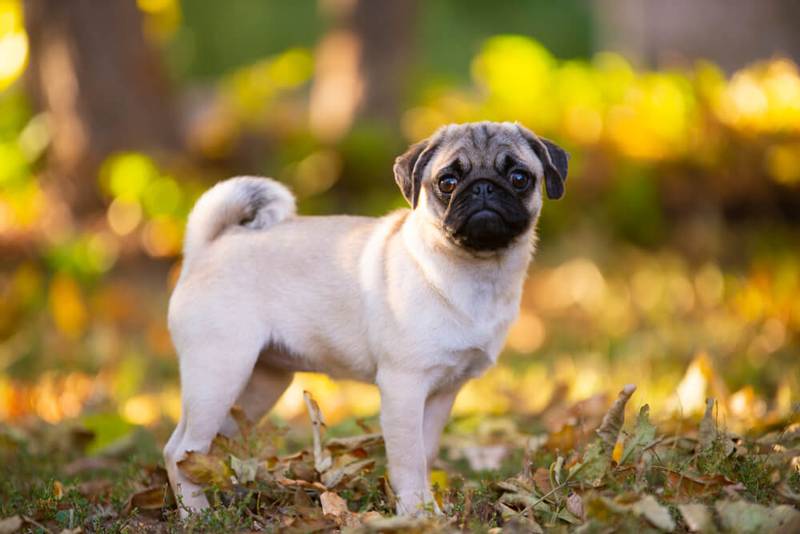
The pug is one of those breeds that, thanks to its characteristic appearance, is easily recognized even by those who do not consider themselves an expert in dog breeding. Of course, modest size and special benevolence do not allow assigning the functions of a reliable guard to this pet, but as a true friend for the whole family and a source of positive emotions, the pug fits perfectly.
History of the pug breed
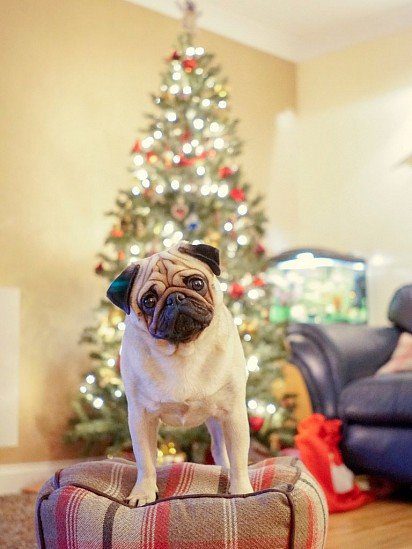
Although visually pugs are somewhat reminiscent of English bulldogs, boxers and the now extinct bullenbeisers from Germany, in fact, their roots should be sought in the East. Moreover, you will have to dig deep, because the first images of short-faced dogs on ancient artifacts that have survived to this day and mention of them in historical documents date back to the 6th-4th centuries BC. The famous ancient Chinese philosopher and politician Confucius speaks of them as companions of the nobility moving on chariots.
For a long time, it was believed that another popular Chinese breed, the Pekingese, originated from pugs .. However, genetic studies allow us to confidently say that family ties are built in the opposite order: long-haired dogs appeared much earlier, their direct ancestors were the Lhasa Apso or Chemdze Apso guarding Tibetan monasteries, and pugs are either a cultivated natural mutation or the result of crossing with others. shorthaired breeds. Perhaps that is why the Pekingese were considered exclusively imperial pets for centuries. But not everyone could afford to have pugs. It was the privilege of the courtiers close to the ruler. The conditions for keeping miniature dogs were truly royal, they ate much better than most ordinary citizens, often had their own chambers, servants for walking and personal protection. An attempt to steal such a dog was punished severely,
Researchers suggest that the first European who happened to see the unusual pets of Chinese nobles was the Venetian merchant and traveler Marco Polo, who lived for seventeen years in an exotic country for a European. His “colleagues” from Holland and Portugal ended up in the Celestial Empire only two centuries later, during the era of the Great Geographical Discoveries. They brought back to their homeland not only silk and spices, but also the charming Lo Chiang Tse, soon renamed “pug” for a simpler pronunciation.
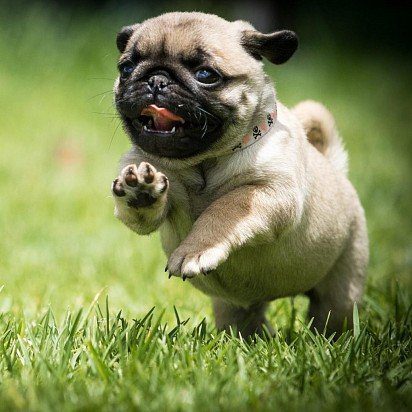
Strong fawn-colored with touching muzzles and big eyes immediately liked the aristocrats of the Old World. However, they played a special role in the fate of the Netherlands: the vigilance of the faithful Pompey helped William the Silent to avoid death at the hands of a hired killer in the midst of the war for independence from Spain. Subsequently, the revolutionary leader of the Low Countries became the founder of the royal Orange dynasty, and the pet accompanied the owner even after his death – a sleeping dog was masterfully carved at the feet of the marble figure of the Dutch founding father on the lid of his sarcophagus. Pugs became a symbol and a living talisman for Wilhelm’s heirs.
Through their efforts, the dogs came to Britain, where they quickly gained popularity with the local nobility, and subsequently dispersed to the royal courts of continental Europe. Especially much for the revival of interest in the breed among the British in the second half of the 19th century was made by Queen Victoria, who doted on her pets. Then the “British” pugs were taller, leaner, with an elongated muzzle and had an exceptionally light color. But, as a result of the sacking of the Beijing Forbidden City during the Second Opium War by officers of the British and French armies, previously unknown black individuals came to the West. The latter are still quite rare and therefore more expensive. In general, pugs are an example of a breed whose popularity is fairly stable.
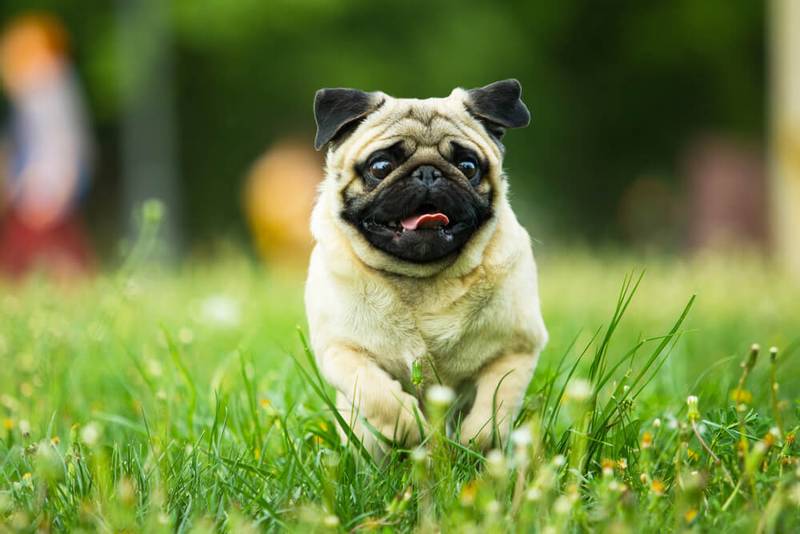
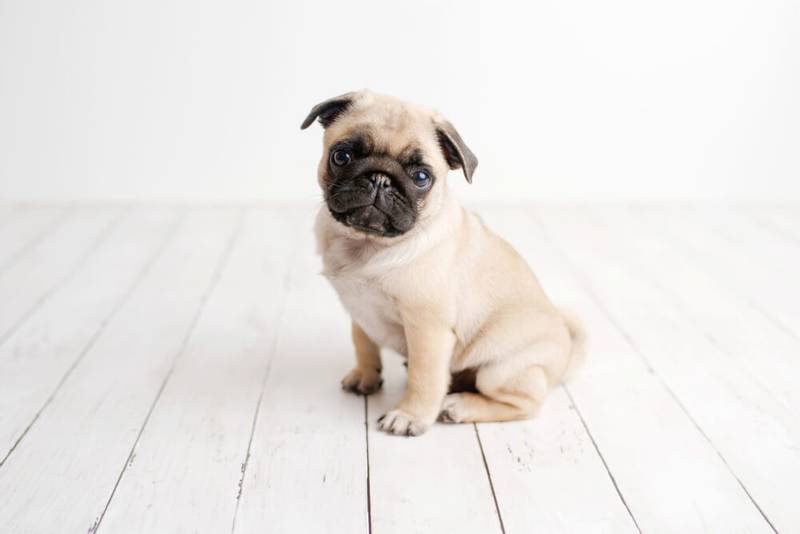
Video: Pug
Appearance of pugs
The ancient breed was recognized by international organizations of dog breeders at the end of the 19th century, and the official standard for pugs was approved only in 1987. Its main criteria are:
Weight and height
The norm for an adult pug is the weight range from 6.3 to 8.1 kg. Height in the standard is not clearly spelled out, but averages 25-30 cm for females and 30-33 cm for males.
General appearance
The pug is a stocky dog with a square outline (the length of the body is equal to the height at the withers). The muscles are well developed, giving the impression of compactness and proportion.
Color
Pugs have fawn (beige), apricot, silver or black colors. In the first three cases, a prerequisite is the most clear contrast between the main (light) color and the dark “mask” on the muzzle, ears. The so-called “belt” is allowed – a dark strip of wool running along the spine from the occiput to the base of the tail, and “diamond” – a dark spot on the forehead.
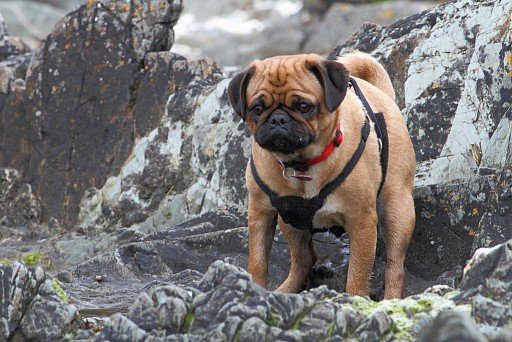

Wool
The pug’s coat is short, fine, close-lying, smooth and soft to the touch. It usually has the same length all over the body, but may be somewhat shorter at the muzzle and slightly longer at the back of the body. In animals of black color, the coat is coarser than in beige and apricot dogs.
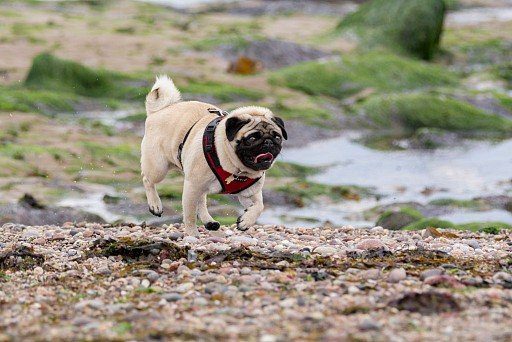
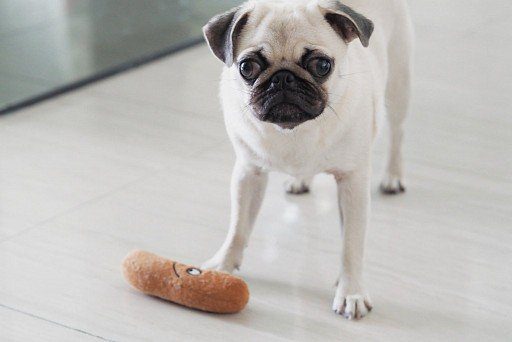
Head
A textbook example of a brachycephalic skull. Large, massive, rounded, but not “apple-shaped”, has no pronounced protrusions and dents, the bones of the skull are invisible. The muzzle is square, short, blunt, but not upturned, with deep symmetrical wrinkles. The forehead does not protrude above the superciliary ridges.
Eyes

Dark (squirrels should not be visible), large, round, rather convex, but not protruding. Set wide apart.
Nose
The bridge of the nose is small, but pronounced, straight, with shortened rather than curved nasal passages. The nose is dark, in line with the eyes and is visually the center of the muzzle.
Jaws
The lower jaw is wide, the chin is well defined. For pugs, a dense undershot bite (no more than 3 mm) is the norm – evenly spaced incisors of the lower jaw overlap the teeth of the upper.
Neck
Strong, powerful, comb-shaped, slightly arched, length in proportion to the body.
Ears
Pug ears are small in relation to the head, thin and very soft. Two forms are acceptable: laid forward, the internal openings of which are closed with edges tightly pressed to the skull (“buttons”), or folded over the head, laid back in such a way that the inside remains open (“roses”). Preference is given to the first.
Torso
Short and massive, with a broad chest and well-defined, arched, laid back ribs. The topline is straight.
Forelimbs
Strong, straight, of moderate length, well set under the body. The paws are neither overly elongated nor pronouncedly rounded, the toes are clearly divided and the nails are black.
Hind limbs
The Pug’s hind legs should be well developed, strong, straight, parallel to each other when viewed from behind, and of moderate length. Knees and hocks have clearly defined angles. The shape of the paws is elongated, but not long. The toes are well separated at the top.
Tail
The pug’s tail is short, thick, densely covered with hair, set high and pressed to the body. Twisted into a ring, with a double coil being preferred.
movements
Springy, free, elegant, confident. The pug’s gait is characterized by light rolling movements.
Possible vices
- convex or “apple-shaped” skull;
- protruding forehead or gaps between the eyes;
- lack of bridge;
- upturned or downturned nose;
- sagging wings;
- disharmonious fold over the nose;
- clarified nose;
- narrow nostrils;
- close-set, light-coloured, almond-shaped, slanting, too small, protruding or with prominent whites of the eyes;
- a twisted mouth that exposes teeth and tongue;
- sagging or arched chest;
- disproportionately long or short neck;
- long and/or fluffy coat;
- straightened joint angles.
Photo of an adult pug
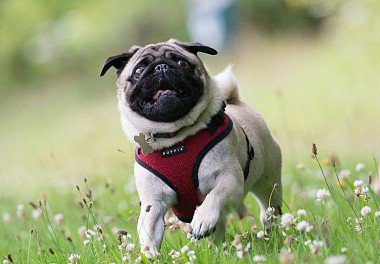
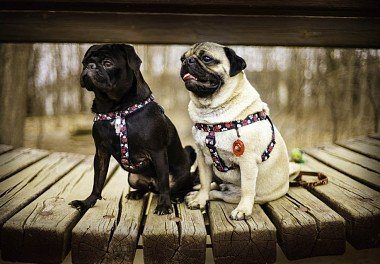
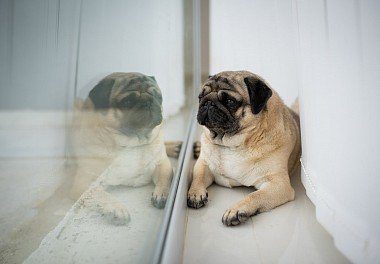
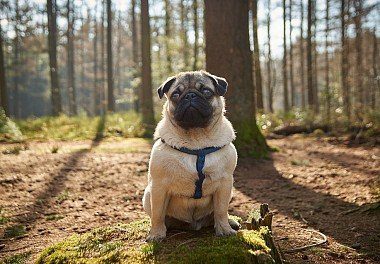
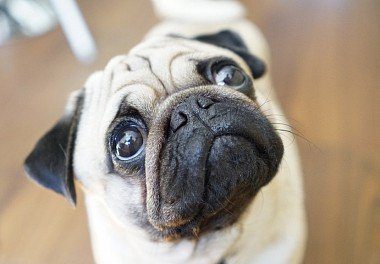
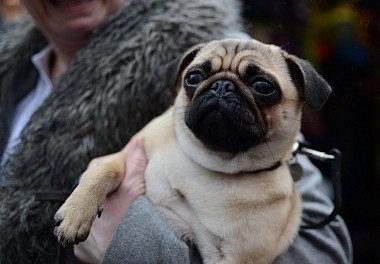

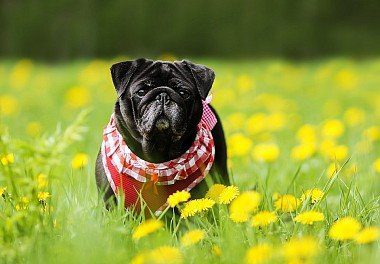
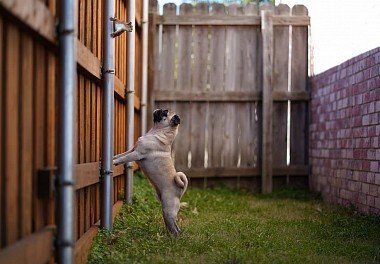
Pug character
As noted above, all pug owners characterize them as friendly and sweet companions. Puppies are quite playful, but as they grow older, the need for active leisure fades away, and the main joy in the life of a pet is quiet hours on the couch in the company of the owner.
Pugs are extremely attached to people, so it is not recommended to leave them alone for a long time, so as not to provoke stress. If you are planning a vacation or another trip, feel free to trust your pet to the care of neighbors or friends – these dogs easily make contact even with strangers who show interest and kind feelings for them. The love of the “little tank” is enough even for children, but their communication is worth keeping an eye on, because during the game they, through negligence, can seriously injure the large and bulging eyes of the animal.
Unlike other decorative breeds, pugs are calm and balanced. They are not characterized by the “spoiled child” syndrome, which can often be encountered when dealing with “lady’s” dogs. If a pug wants your attention, he will just come and sit next to you.
Owners of pugs will not have to listen to their neighbors’ complaints about intrusive barking, which, of course, does not guarantee silence. Your pet will constantly sniff loudly, wheeze and experience bouts of flatulence. And pugs are absolute champions in dog snoring, which you wouldn’t suspect given their modest size. However, the latter is considered by many to be more of an amusing feature than a disadvantage.
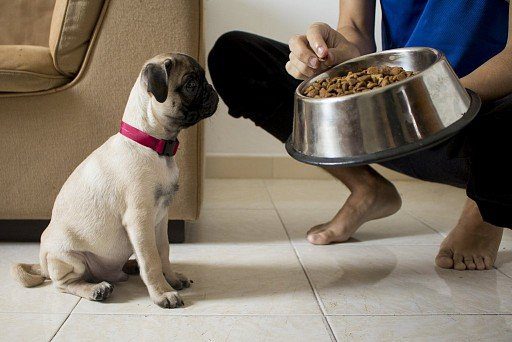
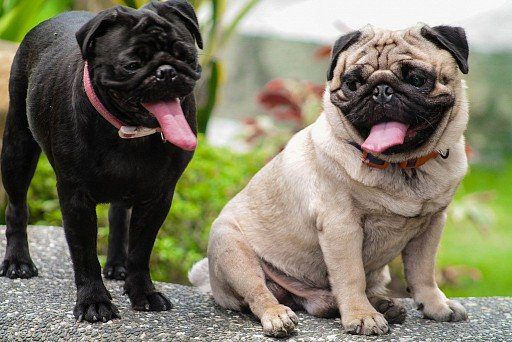
Education and training
Despite their friendliness and sociability, pugs are quite stubborn, so their training seems to be a difficult task, with no guaranteed result. If you still decide to teach your pet simple commands, be patient and … treats. The method of stick and carrot is simply not applicable here. Completely non-aggressive dogs do not tolerate hostility towards themselves, they can only be trained with the help of rewards.
Care and maintenance
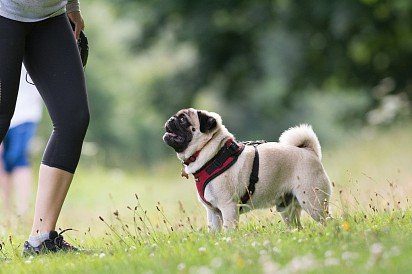
Caring for a pug does not require extra effort from the owner. Short and smooth coat does not need professional grooming, it is enough to comb it at home. During the molting period, which happens twice a year, it is recommended to do this daily, and less often the rest of the time. By the way, the future owner should know that the pug sheds surprisingly abundantly, and be prepared for frequent cleanings. But experts advise bathing a pet as rarely as possible so as not to violate the natural protective barrier on his skin. Bath procedures once a month are considered the best option.
The folds and wrinkles on the muzzle require constant and close attention. They must be cleaned regularly and with all care from particles of food and debris that gets there during your stay on the street. This will avoid inflammation and infections.
The duration of daily walks depends on their intensity. A leisurely walk can take up to an hour and a half, but an easy run should not exceed 10-15 minutes, since your pet’s respiratory system is not designed for marathon races. In addition, it is imperative to take into account the temperature and humidity of the air – for a pug, hypothermia or overheating can become fatal without exaggeration. A short coat without a powerful undercoat does not protect it from low temperatures, so in the cold season it is important not to forget about special clothing. The structural features of the muzzle do not allow efficient removal of excess heat, and even with an increase in body temperature by 3-4 ºС, your pet may die. In connection with this summer, it must be kept in an air-conditioned room.
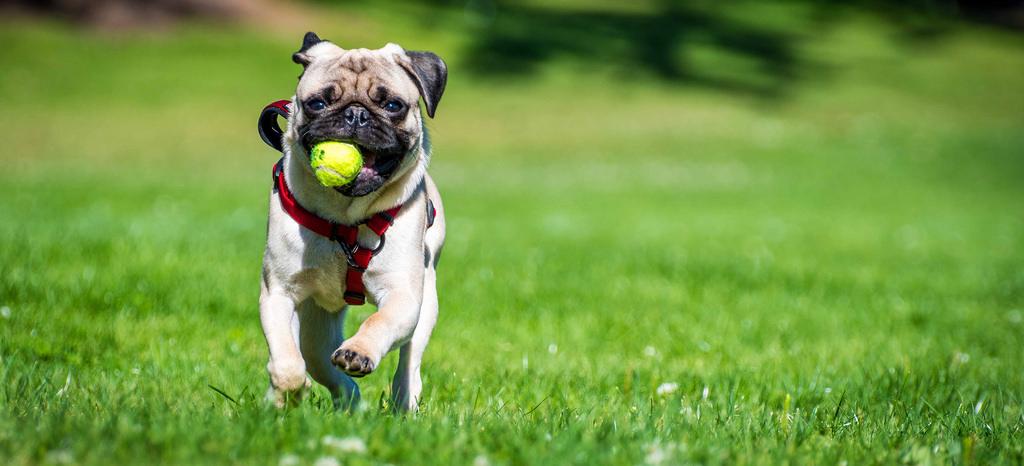
Pug health and disease
Unfortunately, we have to admit that pugs are far from being the healthiest dogs. Throughout their lives, they have to deal with both congenital and acquired diseases. The most serious of the first category are encephalitis, the cause of which has not yet been finally clarified by veterinarians, and epilepsy.
The most vulnerable places in the body of representatives of this breed are the eyes and the respiratory system. Many pets become partially or completely blind as a result of mechanical damage, infections and other diseases. Cases of seasonal or chronic allergies are not uncommon. But the most common problem of this breed is undoubtedly obesity against the background of excessive appetite and low physical activity. By itself, it is not lethal, but reduces life expectancy, exacerbating existing health problems.
How to choose a puppy
The main advice when choosing a pug is not new: contact nurseries with an excellent reputation or experienced breeders, because animals purchased “by hand” or from private announcements can have not only external or disqualifying flaws, but also significant health problems.
Before buying a pug, carefully study the pedigree of the parents, look at the conditions of the animals, get to know the puppy. A healthy baby, in addition to a properly formed skeleton, normative color and the characteristics described in the breed standard, must have a lively friendly disposition, not be afraid of people and not show aggression, not be apathetic.
Photo of pug puppies
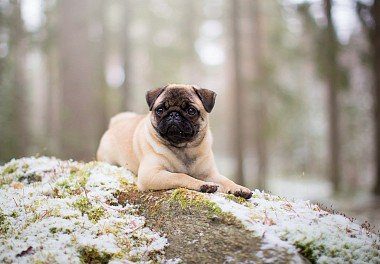
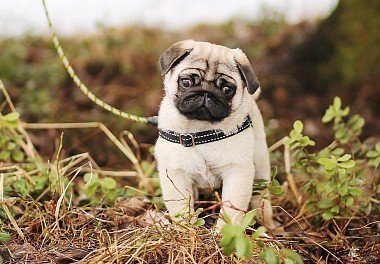
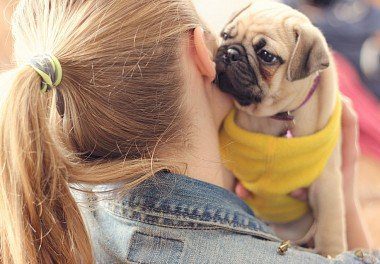
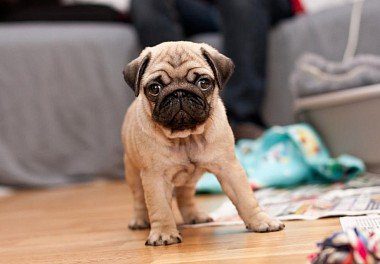
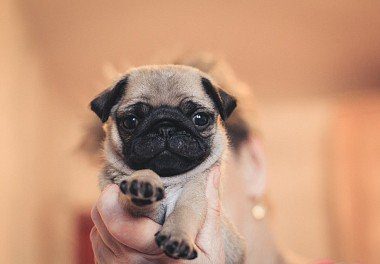
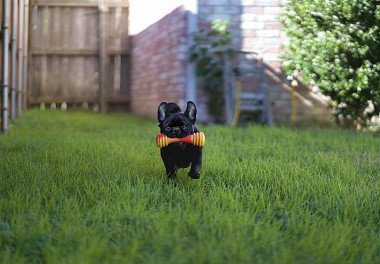
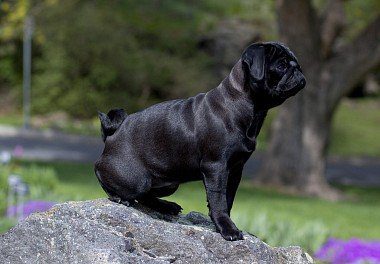
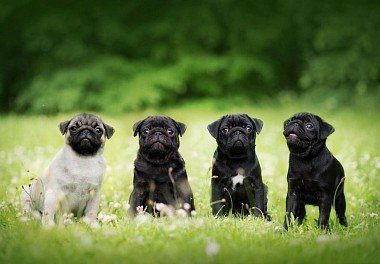
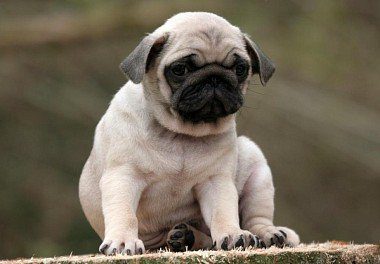
How much is a pug
The price of a pug puppy depends on the eminence of the nursery, its pedigree, individual characteristics and color. Rare black and silver puppies cost more than fawn and apricot pugs. The cost may be lower due to more or less significant deviations from the breed standard. The average price of a pug puppy ranges from 150 to 500$.



